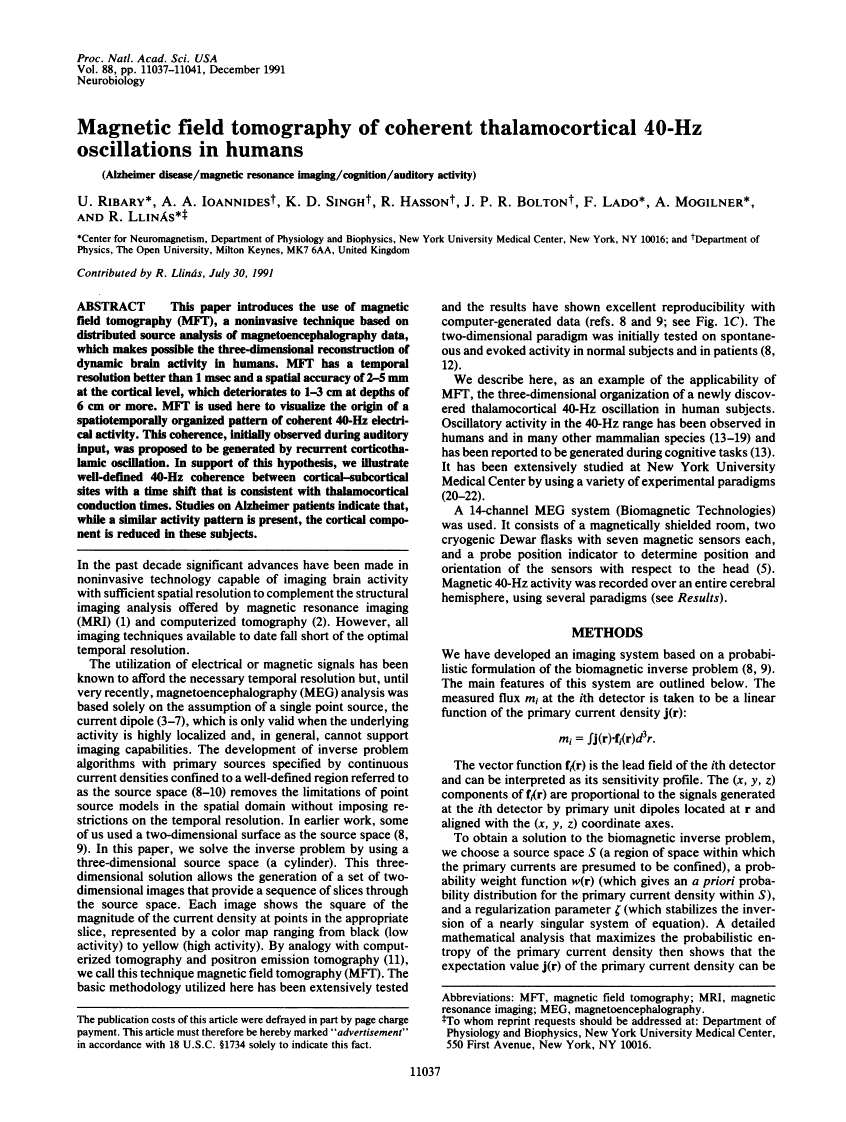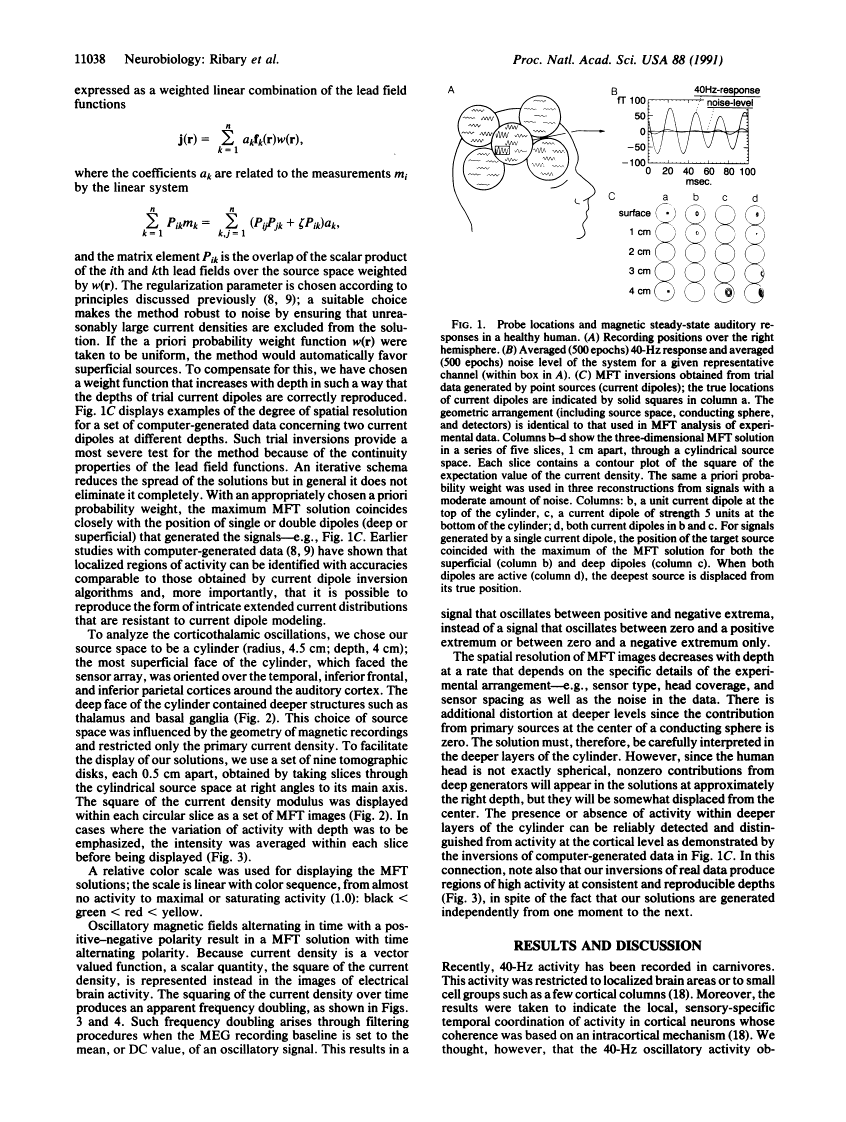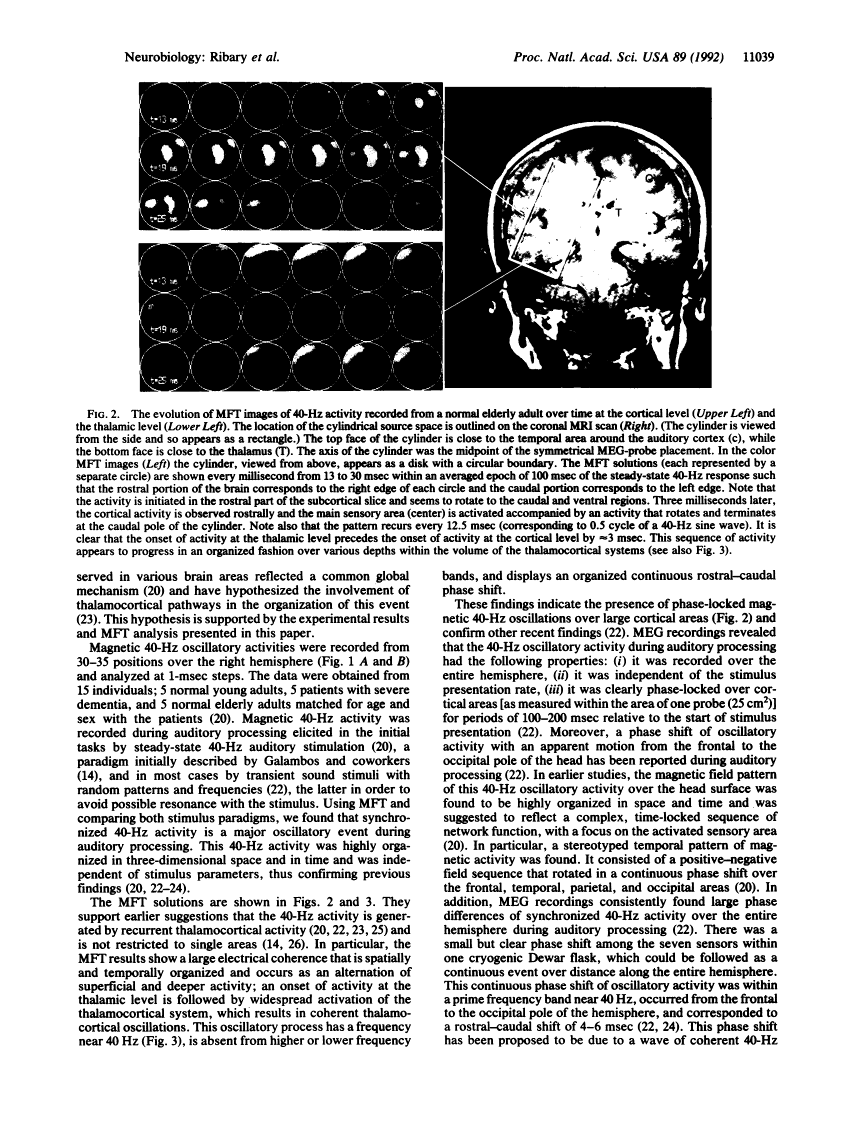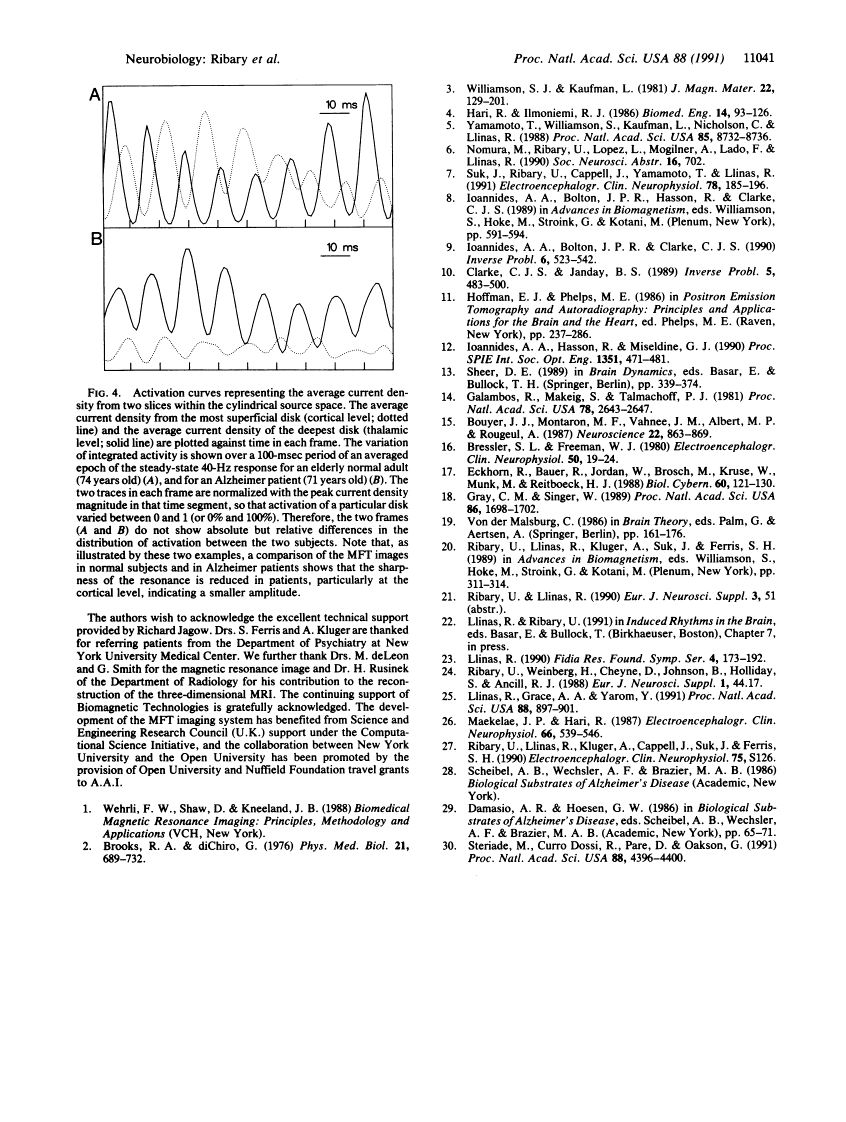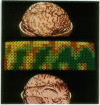Abstract
Free full text

Magnetic field tomography of coherent thalamocortical 40-Hz oscillations in humans.
Abstract
This paper introduces the use of magnetic field tomography (MFT), a noninvasive technique based on distributed source analysis of magnetoencephalography data, which makes possible the three-dimensional reconstruction of dynamic brain activity in humans. MFT has a temporal resolution better than 1 msec and a spatial accuracy of 2-5 mm at the cortical level, which deteriorates to 1-3 cm at depths of 6 cm or more. MFT is used here to visualize the origin of a spatiotemporally organized pattern of coherent 40-Hz electrical activity. This coherence, initially observed during auditory input, was proposed to be generated by recurrent corticothalamic oscillation. In support of this hypothesis, we illustrate well-defined 40-Hz coherence between cortical-subcortical sites with a time shift that is consistent with thalamocortical conduction times. Studies on Alzheimer patients indicate that, while a similar activity pattern is present, the cortical component is reduced in these subjects.
Full text
Full text is available as a scanned copy of the original print version. Get a printable copy (PDF file) of the complete article (1.4M), or click on a page image below to browse page by page. Links to PubMed are also available for Selected References.
Images in this article
Selected References
These references are in PubMed. This may not be the complete list of references from this article.
- Brooks RA, Di Chiro G. Principles of computer assisted tomography (CAT) in radiographic and radioisotopic imaging. Phys Med Biol. 1976 Sep;21(5):689–732. [Abstract] [Google Scholar]
- Hari R, Ilmoniemi RJ. Cerebral magnetic fields. Crit Rev Biomed Eng. 1986;14(2):93–126. [Abstract] [Google Scholar]
- Yamamoto T, Williamson SJ, Kaufman L, Nicholson C, Llinás R. Magnetic localization of neuronal activity in the human brain. Proc Natl Acad Sci U S A. 1988 Nov;85(22):8732–8736. [Europe PMC free article] [Abstract] [Google Scholar]
- Suk J, Ribary U, Cappell J, Yamamoto T, Llinás R. Anatomical localization revealed by MEG recordings of the human somatosensory system. Electroencephalogr Clin Neurophysiol. 1991 Mar;78(3):185–196. [Abstract] [Google Scholar]
- Galambos R, Makeig S, Talmachoff PJ. A 40-Hz auditory potential recorded from the human scalp. Proc Natl Acad Sci U S A. 1981 Apr;78(4):2643–2647. [Europe PMC free article] [Abstract] [Google Scholar]
- Bouyer JJ, Montaron MF, Vahnée JM, Albert MP, Rougeul A. Anatomical localization of cortical beta rhythms in cat. Neuroscience. 1987 Sep;22(3):863–869. [Abstract] [Google Scholar]
- Bressler SL, Freeman WJ. Frequency analysis of olfactory system EEG in cat, rabbit, and rat. Electroencephalogr Clin Neurophysiol. 1980 Oct;50(1-2):19–24. [Abstract] [Google Scholar]
- Eckhorn R, Bauer R, Jordan W, Brosch M, Kruse W, Munk M, Reitboeck HJ. Coherent oscillations: a mechanism of feature linking in the visual cortex? Multiple electrode and correlation analyses in the cat. Biol Cybern. 1988;60(2):121–130. [Abstract] [Google Scholar]
- Gray CM, Singer W. Stimulus-specific neuronal oscillations in orientation columns of cat visual cortex. Proc Natl Acad Sci U S A. 1989 Mar;86(5):1698–1702. [Europe PMC free article] [Abstract] [Google Scholar]
- Llinás RR, Grace AA, Yarom Y. In vitro neurons in mammalian cortical layer 4 exhibit intrinsic oscillatory activity in the 10- to 50-Hz frequency range. Proc Natl Acad Sci U S A. 1991 Feb 1;88(3):897–901. [Europe PMC free article] [Abstract] [Google Scholar]
- Mäkelä JP, Hari R. Evidence for cortical origin of the 40 Hz auditory evoked response in man. Electroencephalogr Clin Neurophysiol. 1987 Jun;66(6):539–546. [Abstract] [Google Scholar]
- Steriade M, Dossi RC, Paré D, Oakson G. Fast oscillations (20-40 Hz) in thalamocortical systems and their potentiation by mesopontine cholinergic nuclei in the cat. Proc Natl Acad Sci U S A. 1991 May 15;88(10):4396–4400. [Europe PMC free article] [Abstract] [Google Scholar]
Associated Data
Articles from Proceedings of the National Academy of Sciences of the United States of America are provided here courtesy of National Academy of Sciences
Full text links
Read article at publisher's site: https://doi.org/10.1073/pnas.88.24.11037
Read article for free, from open access legal sources, via Unpaywall:
https://europepmc.org/articles/pmc53068?pdf=render
Citations & impact
Impact metrics
Citations of article over time
Alternative metrics
Smart citations by scite.ai
Explore citation contexts and check if this article has been
supported or disputed.
https://scite.ai/reports/10.1073/pnas.88.24.11037
Article citations
Can flashing lights stall Alzheimer's? What the science shows.
Nature, 634(8032):22-24, 01 Oct 2024
Cited by: 0 articles | PMID: 39358529
Transcranial alternating current stimulation (tACS) at gamma frequency: an up-and-coming tool to modify the progression of Alzheimer's Disease.
Transl Neurodegener, 13(1):33, 27 Jun 2024
Cited by: 0 articles | PMID: 38926897 | PMCID: PMC11210106
Review Free full text in Europe PMC
The Pathophysiological Underpinnings of Gamma-Band Alterations in Psychiatric Disorders.
Life (Basel), 14(5):578, 30 Apr 2024
Cited by: 0 articles | PMID: 38792599 | PMCID: PMC11122172
Review Free full text in Europe PMC
Abnormal gamma phase-amplitude coupling in the parahippocampal cortex is associated with network hyperexcitability in Alzheimer's disease.
Brain Commun, 6(2):fcae121, 09 Apr 2024
Cited by: 0 articles | PMID: 38665964 | PMCID: PMC11043655
The direction of theta and alpha travelling waves modulates human memory processing.
Nat Hum Behav, 8(6):1124-1135, 08 Mar 2024
Cited by: 6 articles | PMID: 38459263
Go to all (296) article citations
Similar Articles
To arrive at the top five similar articles we use a word-weighted algorithm to compare words from the Title and Abstract of each citation.
Significant thalamocortical coherence of sleep spindle, theta, delta, and slow oscillations in NREM sleep: recordings from the human thalamus.
Neurosci Lett, 485(3):173-177, 15 Sep 2010
Cited by: 5 articles | PMID: 20837102
Phase shift detection in thalamocortical oscillations using magnetoencephalography in humans.
Neurosci Lett, 362(1):48-52, 01 May 2004
Cited by: 18 articles | PMID: 15147778
Synchrony in the interconnected circuitry of the thalamus and cerebral cortex.
Ann N Y Acad Sci, 1157:10-23, 01 Mar 2009
Cited by: 135 articles | PMID: 19351352
Review
Low-frequency rhythms in the thalamus of intact-cortex and decorticated cats.
J Neurophysiol, 76(6):4152-4168, 01 Dec 1996
Cited by: 171 articles | PMID: 8985908
